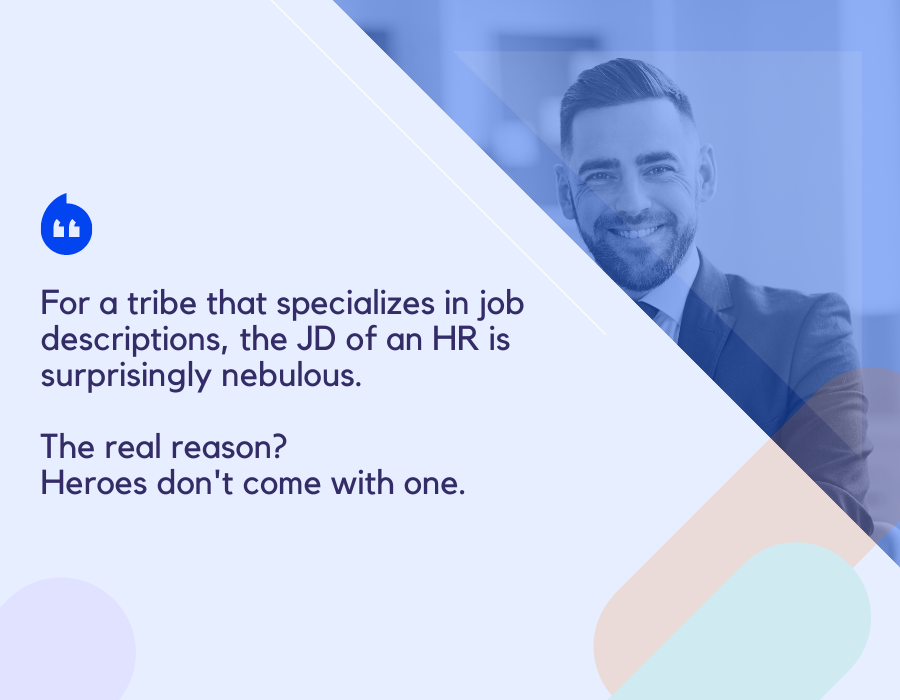Mematahkan Mitos SDM: Apa yang Dipikirkan Orang vs Apa yang Dilakukan HR

Masa depan pekerjaan mungkin sedang berubah, namun hubungan antar manusia akan tetap ada. Apakah kita bekerja dari kantor, rumah, atau Mars, Anda masih harus melambaikan tongkat ajaib agar ninja rockstar dan samurai superstar Anda tidak hanya datang ke air, tetapi juga meminumnya.
Jika ada satu 'Sumber Daya' yang memiliki kekuatan untuk mewujudkannya, maka itu adalah 'SDM'.
Beberapa orang mengatakan bahwa ekonomi tidak akan pernah menjadi ilmu pasti (orang-orang yang sama yang mengerutkan kening ketika seseorang mengatakan, "Saya seorang B.Sc di bidang Lingkungan") karena ilmu ini berurusan dengan ketidakpastian dan ketidakpastian sifat manusia.
Hal yang sama berlaku untuk SDM. Inilah sebabnya mengapa tidak ada pujian yang cukup untuk suku intelektual ini yang telah secara konsisten mencatat hukum alam dan mengubah seni mobilisasi manusia menjadi ilmu pengetahuan (yah, hampir). Dan sebaliknya.

Apa yang Dilakukan HR: Membongkar Mitos
Pahlawan di kehidupan nyata tidak datang dengan JD dan KRA. Mereka mengarangnya sendiri, yang membuat mematahkan banyak mitos SDM yang terkait dengan pekerjaan mereka menjadi hal yang menyenangkan dan mendesak. Mari kita bongkar semuanya.
Mitos SDM #1
- Apa yang orang pikirkan tentang pekerjaan HR: Menaikkan tiket
- Apa yang dilakukan oleh SDM: Meningkatkan permainan
Contoh kasus: Dalam hal memastikan bahwa keluhan pekerja mendapat tempat terhormat dalam proses pengambilan keputusan, departemen SDM di FedEx Corporation-seperti halnya merek itu sendiri-memberikan hasil yang lebih baik dari yang diharapkan.
Filosofi perusahaan yaitu People-Service-Profit, yang disusun pada tahun 1970-an, terus bergaung kuat di abad ke-21 ini. Setiap tahun, tim SDM melakukan survei yang tajam dan program aksi umpan balik yang menambang umpan balik yang berharga bagi manajemen untuk meninjau dan mengubah kerangka kerja budaya.
Dan formulir yang diisi oleh semua orang itu? Ya, mereka melakukan hal ini untuk mencapai tujuan yang cukup mulia: Membangun tempat kerja yang mencerminkan semangat komunitas yang sesungguhnya dan memberdayakan aspirasi tak terucapkan dari orang-orang baik di FedEx.
Mitos SDM #2
- Apa yang orang pikirkan tentang apa yang dilakukan oleh SDM: Membangun dinding (api) dan langit-langit (kaca)
- Apa yang dilakukan oleh SDM: Membangun rumah (kedua)
Contoh kasus: Cadbury bersaudara (ya, orang-orang di balik kelezatannya) adalah pelopor dalam hubungan industrial dan kesejahteraan karyawan. Pada akhir tahun 1870-an, ketika bisnis mereka berkembang pesat, mereka mengambil keputusan radikal yang mencengangkan untuk memindahkan sebagian operasi mereka ke pedesaan.
Hal ini terjadi jauh sebelum revolusi pedesaan Zoho dan didasarkan pada keyakinan bahwa jika alam yang masih asli dan makanan organik cukup baik untuk ditinggali dan dimainkan, maka hal tersebut juga cukup baik untuk berolahraga.
Buku-buku warisan tentang SDM dengan cepat ditulis ulang. Mulai dari program renang hingga ruang ganti berpemanas hingga taman terpisah untuk wanita dan pria (semua belum pernah terdengar pada saat itu), Desa Bournville Cadbury-sekarang menjadi komunitas modern yang berkembang pesat-tidak hanya menjadi pencipta tren yang sesungguhnya, namun juga tetap menjadi inspirasi bagi para pemimpin SDM yang mengutamakan manusia untuk menciptakan kembali daya pikat 'rumah' di tempat kerja.
Mitos SDM #3
- Apa yang orang pikirkan tentang SDM: Memainkan permainan pikiran
- Apa yang dilakukan oleh SDM: Membangun taman bermain untuk pikiran
Contoh kasusnya: Para pemikir SDM di Quicken Loans, sebuah organisasi yang masuk dalam jajaran 5 Besar Tempat Kerja Terbaik versi Majalah Fortune, dengan susah payah menyingkirkan belenggu dan birokrasi dari alur kerja untuk menciptakan budaya kolaborasi dan kreativitas tanpa batas, sesuatu yang mendorong karyawan untuk mengambil lompatan tanpa takut gagal.
Perusahaan ini percaya bahwa ketika orang memiliki penyangga psikologis untuk bersandar, mereka dapat mencapai ketinggian yang spektakuler dan melakukan hal-hal hebat. Di DreamWorks Animation, di sisi lain, karyawan didorong untuk memamerkan hobi, karya seni, atau proyek pribadi mereka (yang ada hubungannya dengan pekerjaan perusahaan) di siang bolong. Pengakuan publik atas kemampuan seperti itu jauh lebih memompa semangat pekerja daripada bonus apa pun.
Mitos SDM #4
- Apa yang orang pikirkan tentang apa yang dilakukan oleh SDM: Mengendalikan kami
- Apa yang dilakukan oleh SDM: Membantu kami memerintah
Contoh kasus: Para pemimpin talenta Hyatt mengubah kebijakan SDM mereka dengan memperluas tingkat keramahan yang sama (yang mereka berikan kepada para tamu dan pelanggan mereka) kepada para karyawan mereka.
Sebagai hasilnya, para karyawan di Hyatt terinspirasi untuk membawa 'avatar mereka yang sesungguhnya' ke tempat kerja, menciptakan pengalaman pelanggan otentik yang dibuat dan dibentuk berdasarkan ikatan yang tulus. Saus rahasia ini, seiring berjalannya waktu, menjadikan Hyatt identik dengan 'pengalaman menginap yang luar biasa' yang akan terus diingat tamu setelah mereka check-out.
Dengan cara yang sama, SouthWest Airlines memberikan kebebasan kepada karyawannya untuk mendesain dunia mereka, termasuk seragam dan keseimbangan antara pekerjaan dan kehidupan pribadi mereka. Rasa bahagia biasanya menular, muncul dalam perilaku mereka dengan pelanggan dan mencerminkan merek secara positif. Alih-alih mengekang kami, HR membebaskan mereka untuk berkuasa dan bersinar.
Mitos SDM #5
- Apa yang orang pikirkan tentang apa yang dilakukan SDM: Mempekerjakan
- Apa yang dilakukan oleh SDM: Membawa kita lebih tinggi
Contoh kasus: Di The Admiral Group, orang-orang bisa memberikan kembali kepada masyarakat melalui kegiatan amal, merajut tim menjadi lebih dekat untuk sebuah tujuan bersama yang lebih besar daripada target bisnis apa pun. Di Cisco, budaya yang mengutamakan layanan mendorong karyawan untuk menjangkau komunitas lokal.
Reaksi berantai positif yang dilepaskan secara luas dianggap telah mendorong, dengan caranya yang unik, kenaikan saham, ekuitas, dan niat baik Cisco tanpa henti selama bertahun-tahun.
Mitos SDM #6
- Apa yang orang pikirkan tentang pekerjaan SDM: Pagar pembatas di atas kita
- Apa yang dilakukan oleh SDM: Mengawasi kita (ala malaikat pelindung)
Contoh kasus: 'Malaikat yang Menyamar' adalah salah satu KRA yang disamarkan oleh SDM Anda. Begitu juga di Health Catalyst, di mana suku yang selalu gesit dan penuh empati ini membantu seorang pekerja membangun lingkungan hidup yang terkendali bagi seorang anak yang baru lahir dengan defisiensi imun yang langka.
Orang-orang di BAF juga tidak kalah 'protektif' terhadap kawanan mereka: Ketika salah satu karyawan mereka mengalami kecelakaan parah di jalan raya, perusahaan ini dengan sigap memindahkan mereka dari lantai tiga ke apartemen di lantai satu.
Tidak hanya itu. Mereka melengkapi apartemen dengan semua teknologi dan sistem yang dibutuhkan pekerja untuk tetap terhubung dengan pekerjaan selama masa pemulihan. Pada saat-saat yang tidak biasa ini, kami menyaksikan wajah terbaik HR: Tanpa pamrih, masuk akal dan selalu mengutamakan kepentingan karyawan dan organisasi.
SDM: Peran yang Membuat Kami Bergerak
'Jam-jam yang Membantu' dari Accenture yang memungkinkan karyawan menyumbangkan cuti mereka kepada rekan kerja yang 'membutuhkan', cuti ayah dari Flipkart, 'waktu hobi' dari Google, peran fleksibel dari BHEL yang memungkinkan karyawan untuk menjelajahi bidang lain, Audisi Bakat dari Godrej (mereka menyebutnya LOUD: Live Out Your Dreams), kebiasaan Marriott memanggil karyawan dengan sebutan 'rekan kerja' yang langsung memperbaiki hubungan, Masyarakat Drama-Musik-Tari SAP Labs, peluang yang berpusat pada keragaman dari Coca Cola, dan keyakinan ITC terhadap talenta muda yang mereka beri penghargaan dengan peran-peran yang memperkaya, semuanya merupakan contoh-contoh sumber daya spektakuler yang menyelamatkan jiwa dari Sumber Daya Manusia terhebat yang pernah ada: SDM.
Ada Sedikit SDM dalam Diri Kita Semua
Jika Anda berpikir Sumber Daya Manusia adalah satu departemen dengan lokasi, ruang atau kubikel tertentu, pikirkan lagi. SDM Anda tersebar di seluruh kantor Anda. Para eksekutif SDM meluncur dan melenggang dengan mudah melalui setiap pintu dan departemen (sebagian besar waktu tanpa disadari oleh siapa pun), secara diam-diam memangkas 'I' di sini dan dengan lembut menyetel 'T' di sana sehingga kondisinya sudah matang dan tepat saat tiba waktunya untuk naik ke atas panggung dan memberi isyarat untuk meraih kejayaan.
Ya, untuk setiap penampilan yang luar biasa dari tim Sales, TI atau Produk, ada 'penginjil manusia' yang penuh dedikasi dan semangat di suatu tempat di sayap yang dengan hati-hati menyingkirkan kerikil dan ranjau darat agar kami dapat terus berjalan. Dapatkah kita berdiri sekali lagi untuk menerima tepuk tangan yang telah kita lewati dengan tidak berperasaan?
Setiap Peran Membutuhkan Sentuhan Keajaiban SDM untuk Menjadi Miliknya
- Manajer Produk yang perlu menambahkan suntikan adrenalin baru pada ide dengan menstimulasi pemikiran yang tidak konvensional.
- Supervisor yang perlu menghargai niat jujur secara konsisten dari seorang polisi yang lebih memilih untuk tetap berada dalam bayang-bayang.
- Pemimpin Penjualan yang membutuhkan sedikit dorongan dan pelatihan untuk mencapai langkah emas.
- Pemimpin Pendapatan yang membutuhkan lebih banyak waktu tatap muka dengan tim untuk mengoptimalkan proses.
- CXO yang perlu makan siang dengan karyawan magang untuk menanamkan sifat-sifat budaya (seperti kepercayaan, keadilan, dan sikap belajar) dari bawah ke atas.
Ketika ada masalah, mereka memiliki strategi yang umum dan sederhana: "PANGGIL SDM."
Jadi, mari kita lakukan hal itu, bukan? Mari kita sebut orang-orang ini apa adanya: Para pemikir, arsitek, psikiater, guru, tentara, pencipta perdamaian, penyembuh, dan pembuat keajaiban yang menata ulang kebiasaan dan habitat kita bata demi bata. Sehingga kita dapat menemukan tujuan hidup kita, memberdayakan potensi kita, dan mengejar impian kita.
